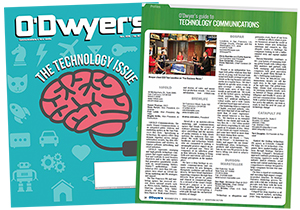 Julie Karbo Julie Karbo |
|
|
AI conjures up images of HAL from the legendary film “2001: A Space Odyssey,” conjuring the fear that we’ll lose control and a sense of humanity. Do we agree with renowned scientist Stephen Hawking when he tells the BBC, “The development of full artificial intelligence could spell the end of the human race?” Most of us don’t plan to retreat to a cabin in the woods and stockpile supplies.
On the flipside, we may not want to utilize every trendy tool and turn over our power of decision-making to automated communication, or lose our perspective in a sea of analytics. While AI and other technologies have the possibility of running amok without the proper controls in place, today’s technology can help us to increase our knowledge, reach and power when it comes to communicating effectively and influencing the behavior of those we are trying to reach. No cyborg armies here, but simply getting the right information to the right person at the right time in the right way.
To this end, how can we ensure we exercise the perfect balance between automation and the human touch in PR?
The first step is very human and not machinelike: introspection. What are we trying to accomplish? There’s no way to automate this part of the process. The bigger danger is letting the ‘sparkle’ of shiny tools and data, make even the most experienced marketer jump right to program execution rather than do the soul-searching required to answer this foundational question.
With our goals clearly defined, the next step is to see where the intelligence gaps lie. Do we understand the target market? What might help us understand this market better? One benefit of the IoT is that sensors can reside in everything — even the smallest, most remote device — and deliver real-time information about the most geographically dispersed people or things. How can access to this data help PR?
Understanding our target market helps us tailor our messages appropriately, but we must still go where those we want to reach are. Those we seek to influence are increasingly consuming digital media unhampered by location or time. By evaluating this richer consumer behavior data, we can make smarter decisions about where and how to influence them.
Once we collect information about current behavior we can deliver content based on preferences, behavior and predictive analytics. After we identify desired targets we can customize messages to them based on their qualities and needs. This could mean delivering a coupon for clothing they covet that is sold at a nearby store, tweeting about a local concert by their favorite artist when tickets go on sale, or surveying visitors about an important local initiative when they are within a specific geographic area. AI can automate and deliver personalized content based on these factors. And it can be even more personalized than the ads delivered to Tom Cruise in “Minority Report.”
There are many essential PR functions that are more effectively executed via technology, including:
• Paid content delivery according to demographics, location, behavior and device.
• Social media advertising targeting via market category and demographics.
• Social channel monitoring and measurement.
• Results measurement and reporting.
• News discovery.
• The integration of PR data into enterprise applications such as CRM, ERP, etc.
What should remain uniquely human? Setting objectives and strategies, and developing messaging and creative campaigns that go beyond simply replicating cognitive thinking. These require the combination of human abilities that no computer or technology has yet to imitate fully: logical thinking, understanding, empathy, artistry and creativity.
Relationships with key reporters and other influencers can’t and shouldn’t be outsourced either. The connection we make with our fellow humans whether over the phone, electronically or by literally “pressing the flesh,” can’t be replicated by even the most attractive robots at this point (sorry, “Westworld”). The sharing of our very human traits, values and even faults engenders connection.
The same is true for social media. We can tweet messages and videos, post to Facebook, Instagram, Snapchat and Linkedin, but the conversational part must be human, based on individual connections. Reacting to news and fast-moving trends requires evaluation, emotional context and sensitivity. Even video, while it can be widely disseminated, remains a very personal medium. Snapchat is the perfect example of this. And who would really trust crisis management to an automated process?
It’s critical to know where the line between technology, human-driven thinking and connection must be drawn. Technology-based tools can make us smarter, but, we have to use them wisely. The IoT and AI can give us greater understanding and can amplify our voice by giving us broader and more fruitful access to our target markets, customers, influencers.
Rather than look at the Internet of Things and AI as overpowering forces, we must see them as instruments that will help us craft The Internet of Influence. We have to determine how we harness the medium, the message, and determine when we are uniquely, humanly influential.
***
Julie Karbo is Founder and CEO of Karbo Communications, a digital PR and marketing agency based in San Francisco.



 Laura Anderson, who rose to VP/GM of global communications and events in a nearly 20 year stint at Intel, will take on the Americas technology chair at Burson following the completion of the BCW and H+K merger on July 1.
Laura Anderson, who rose to VP/GM of global communications and events in a nearly 20 year stint at Intel, will take on the Americas technology chair at Burson following the completion of the BCW and H+K merger on July 1. WE Communications has partnered with ROKK Solutions to form the WE ROKK AI service.
WE Communications has partnered with ROKK Solutions to form the WE ROKK AI service. In the dynamic world of modern business, effective communication is a pivotal tool for success across various industries. At Communications Strategy Group (CSG®), our expertise in embracing innovation in communication extends beyond traditional marketing strategies, paving the way for transformative industry-specific solutions.
In the dynamic world of modern business, effective communication is a pivotal tool for success across various industries. At Communications Strategy Group (CSG®), our expertise in embracing innovation in communication extends beyond traditional marketing strategies, paving the way for transformative industry-specific solutions. There are two types of tech PR professionals. Which one are you? And are C-suite executives making that decision for you?
There are two types of tech PR professionals. Which one are you? And are C-suite executives making that decision for you? While there’s an impulse to grab reporters’ attention with the newest industry-transforming tech product or service, a back-to-basics approach focused on telling the right stories to the right people is a far more successful way to ensure your technology campaign breaks through the clutter of today’s crowded tech landscape.
While there’s an impulse to grab reporters’ attention with the newest industry-transforming tech product or service, a back-to-basics approach focused on telling the right stories to the right people is a far more successful way to ensure your technology campaign breaks through the clutter of today’s crowded tech landscape.


 Have a comment? Send it to
Have a comment? Send it to 
No comments have been submitted for this story yet.